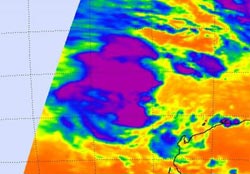NASA infrared satellite data gives System 96S a fair shot at becoming a tropical cyclone

A NASA AIRS instrument infrared image captured on Feb. 9 at 17:47 UTC (12:47 p.m. EST) showed some strong convection and strong thunderstorms (purple) with very cold cloud-top temperatures, around the center of System 96S. Credit: NASA/JPL, Ed Olsen<br>
When Aqua passed over System 96S on Feb. 9 at 17:47 UTC (12:47 p.m. EST), the Atmospheric Infrared Sounder (AIRS) instrument showed some strong convection and strong thunderstorms with very cold cloud-top temperatures around the center of circulation.
Those cloud top temperatures were as cold as or colder than -63 Fahrenheit/-52 Celsius indicating strong convection, strong thunderstorms, and heavy rainfall. The imagery suggests that the convection is consolidating and increasing around the low's center.
Convection is limited on the eastern half of System 96S because of moderate vertical wind shear (winds that can weaken a storm) blowing near 30 knots (34 mph/55 kmh)! That wind shear, however, is expected to weaken and enable the low to strengthen. Another factor that will help System 96S strengthen is the warm sea surface temperatures that it's located in. Sea surface temperatures are estimated near 30 degrees Celsius (86 Fahrenheit). Tropical Cyclones need sea surface temperatures of at least 26.6 Celsius (80 Fahrenheit) to maintain strength or intensify.
At 2300 UTC on Feb. 9, (6 p.m. EST) System 96S had maximum sustained surface winds near 20 to 25 knots (23 mph/ 37 kmh to 29 mph/46 kmh). It was located about 260 miles (418 km) northwest of Barrow Island, Australia near 17.7 South and 112.2 East. Residents of Western Australia are keeping a close eye on this system for development.
Media Contact
More Information:
http://www.nasa.govAll latest news from the category: Earth Sciences
Earth Sciences (also referred to as Geosciences), which deals with basic issues surrounding our planet, plays a vital role in the area of energy and raw materials supply.
Earth Sciences comprises subjects such as geology, geography, geological informatics, paleontology, mineralogy, petrography, crystallography, geophysics, geodesy, glaciology, cartography, photogrammetry, meteorology and seismology, early-warning systems, earthquake research and polar research.
Newest articles

Superradiant atoms could push the boundaries of how precisely time can be measured
Superradiant atoms can help us measure time more precisely than ever. In a new study, researchers from the University of Copenhagen present a new method for measuring the time interval,…

Ion thermoelectric conversion devices for near room temperature
The electrode sheet of the thermoelectric device consists of ionic hydrogel, which is sandwiched between the electrodes to form, and the Prussian blue on the electrode undergoes a redox reaction…

Zap Energy achieves 37-million-degree temperatures in a compact device
New publication reports record electron temperatures for a small-scale, sheared-flow-stabilized Z-pinch fusion device. In the nine decades since humans first produced fusion reactions, only a few fusion technologies have demonstrated…





















